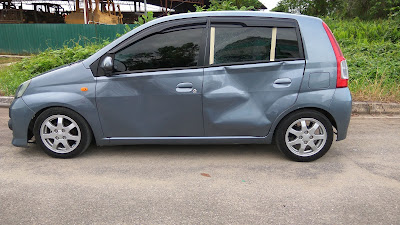Last weekend, I had an opportunity to restore a family friend's BMW 525i headlights. It was in a terrible condition due to old age of the car and most probably had been exposed in the sun for too long.
 |
| The condition of the headlights before restoration |
It had tiny cracks on it, and it was quite yellowish. The light output wasn't that bright as the casing is very blurry. The owner contacted me, booked a time slot for the service, and the car was done in 3 hours, as the headlamp was in a really bad shape.
If you are thinking of attempting this project on your own, you will need;
1. 500 grit, 800 grit, 1000 grit, 1500 grit sandpaper
2. A spray bottle filled with soapy water
3. A bucket filled with water
4. Samurai 2K-in-a-can Clearcoat
5. Newspapers and painters' tape
6. A clean microfibre towel
7. Lots and lots of time.
If the condition of the headlights is not that bad, you can skip the 500 grit sandpaper entirely. But then, if 800 grit sandpaper could not sand down the case, you will need it.
First off, the headlights were taped around it with painters' tape as when you wetsand it, there are chances that you will accidentally sand the paint with it when sanding the edges of the headlights. To protect the paint, it is essential to cover the paint around it. Before sanding, soak all of the sandpapers in water for at least 10 minutes before sanding.
Start off by wetting the headlamp and the sandpaper with soapy water. Then, start sanding with 500 grit sandpaper in one direction. The trick is to sand either horizontally or vertically and change the direction when you change the grit of the sandpaper. For example, if you're sanding 500 grit horizontally, sand 800 grit vertically. This is to ensure that the whole surface is covered and there are less high and low spots. When sanding, make sure that the surface is always wet. When the cracks appear to be less, move on with 800 grit until the surface is flat to touch. Then, move on with 1000 grit sandpaper, and end with 1500 grit sandpaper.
 |
| After sanding. |
For this particular project, I used the Samurai 2K Clearcoat which I had mentioned previously in the post where
I sprayed my car bumper. The instructions are affixed at the can, where the 2 parts are mixed. When it is opened and mixed, make sure to use it within 4 hours.
 |
| Samurai's 2K in a Can |
I learned this from a paint shop in Kuching, and when you use this clear coat, the coat can last for 3-5 years, depending on the weather and how the car is maintained. I forgot to take the photo as the winds were blowing strongly at the time and I was rushing for the car to be completed.
Before using the product, make sure that the surface is clean and dry. Cover
EVERYTHING that may be in contact with the mist coming from the 2K clearcoat. I learned this lesson the hard way as the clearcoat mist came in contact with my Viva and it left a very rough surface on the car.
Spray the headlamp with multiple coats, and make sure that there are flash times between coats, meaning that before spraying another coat, the underlying coat is dry enough. When it is not dry enough, cracks can form on the clearcoat and it will look horrible. When you are done, let it dry properly.
 |
| After clearcoating. |
When it is dry enough, it leaves a hard & glasslike coating which will last quite some time.
 |
| At a different angle |
 |
| Close-up |
If you are in Sibu, and is interested to do a headlight restoration on your car, just drop a comment below and I will reply to you soonest.
For the DIYers, happy DIYing!

















































